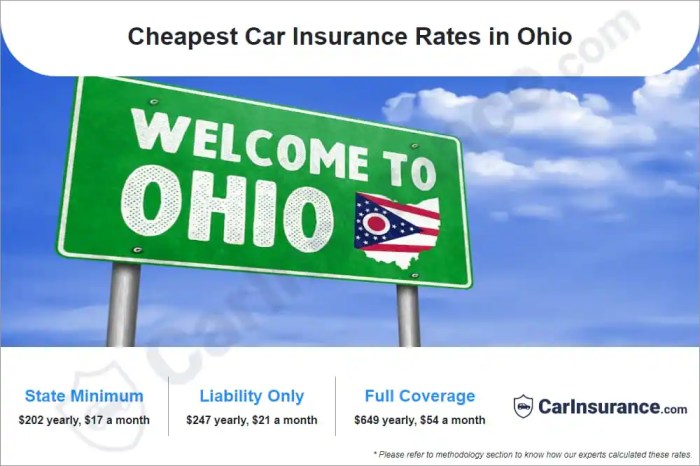Securing the right car insurance in Ohio is crucial, balancing legal compliance with financial protection. Ohio’s insurance landscape presents a mix of mandatory coverages, diverse policy options, and factors influencing premiums. This guide unravels the complexities, providing a clear understanding of Ohio’s car insurance requirements, available coverage types, cost-saving strategies, and the claims process.
From understanding minimum liability limits and penalties for non-compliance to exploring the nuances of collision, comprehensive, and uninsured/underinsured motorist coverage, we aim to empower Ohio drivers to make informed decisions about their insurance needs. We’ll also delve into strategies for finding affordable insurance, including leveraging discounts and understanding the impact of your driving record and vehicle type on your premiums.
Factors Affecting Car Insurance Premiums in Ohio

Securing affordable car insurance in Ohio involves understanding the various factors that influence your premium. Several key elements contribute to the final cost, and being aware of these can help you make informed decisions to potentially lower your rates. This section will detail the most significant factors impacting your car insurance premiums.
Driving History’s Impact on Insurance Costs
Your driving record significantly impacts your car insurance premium. A clean driving record, free from accidents and traffic violations, will generally result in lower premiums. Conversely, accidents and tickets, especially serious ones like DUIs, significantly increase your risk profile and, consequently, your insurance costs. Insurance companies view a history of accidents and tickets as indicators of higher risk, leading them to charge more to cover the increased probability of future claims. For example, a single at-fault accident might increase your premium by 20-40%, while multiple accidents or serious violations can lead to even steeper increases or even policy cancellations.
The Role of Age in Determining Premiums
Age is another crucial factor. Younger drivers, particularly those under 25, are statistically more likely to be involved in accidents, leading to higher premiums. This is due to factors such as inexperience, risk-taking behavior, and a higher likelihood of speeding or other traffic violations. As drivers gain experience and age, their premiums typically decrease, reflecting a lower risk profile to insurance companies. For instance, a 16-year-old driver will likely pay significantly more than a 35-year-old with a clean driving record.
Credit Score’s Influence on Car Insurance Rates
In Ohio, as in many other states, your credit score can influence your car insurance premiums. Insurance companies often use credit-based insurance scores (CBIS) to assess risk. A good credit score generally indicates responsible financial behavior, which is often correlated with responsible driving behavior. Conversely, a poor credit score might lead to higher premiums, reflecting a perceived higher risk. It’s important to note that while credit scores are a factor, they are not the sole determinant of your premium. Other factors are considered in conjunction with your credit history.
Vehicle Type and Insurance Premiums
The type of vehicle you drive directly affects your insurance costs. Generally, high-performance vehicles, sports cars, and luxury cars are more expensive to insure due to their higher repair costs and greater potential for theft. Conversely, smaller, more fuel-efficient cars tend to have lower insurance premiums. The vehicle’s safety features also play a role; cars with advanced safety technologies like anti-lock brakes and airbags may qualify for discounts.
Location’s Impact on Car Insurance Costs
Your location in Ohio plays a significant role in determining your car insurance premium. Insurance companies consider the accident rates and crime rates in your area when calculating premiums. Areas with higher rates of accidents and theft will generally have higher insurance premiums than areas with lower rates. This is because insurance companies anticipate a higher likelihood of claims from these higher-risk locations.
Understanding Ohio’s SR-22 Requirements

An SR-22 is a certificate of insurance that proves you have the minimum car insurance coverage required by Ohio law. It’s not a type of insurance itself, but rather a form that your insurance company files with the Ohio Bureau of Motor Vehicles (BMV) to verify your compliance. Understanding when an SR-22 is required and the process involved is crucial for maintaining your driving privileges in Ohio.
When an SR-22 is Required in Ohio
An SR-22 is mandated by the Ohio BMV in specific situations, typically after a driver has been convicted of certain driving offenses. These offenses often involve serious violations like driving under the influence (DUI), driving without insurance, or causing an accident resulting in significant damage or injury. The severity of the offense and the driver’s history will determine the length of time the SR-22 is required. Essentially, it serves as proof to the state that the driver is maintaining the required minimum insurance coverage, demonstrating responsibility and mitigating future risks.
Obtaining an SR-22
The process of obtaining an SR-22 is relatively straightforward. First, you’ll need to find an insurance provider willing to issue an SR-22. Many major insurance companies offer this service. Once you have secured insurance coverage that meets the state’s minimum requirements, your insurance company will file the SR-22 electronically with the Ohio BMV on your behalf. You will likely need to provide them with documentation related to your driving record and the specific court order or requirement mandating the SR-22. The cost of the SR-22 is typically included in your insurance premium. There’s no separate fee for the certificate itself.
Implications of Not Maintaining an SR-22
Failing to maintain an SR-22 after it has been mandated by the Ohio BMV has serious consequences. The BMV will likely suspend your driver’s license, meaning you’ll be unable to legally drive. This can lead to further fines and legal repercussions. Furthermore, it can significantly impact your ability to secure future insurance coverage, as many companies will be hesitant to insure someone with a history of non-compliance. Maintaining the SR-22 is vital to avoid these negative impacts.
Duration of SR-22 Requirement
The length of time an SR-22 is required varies depending on the nature of the offense and the driver’s history. It can range from one to three years, or even longer in some cases. The Ohio BMV will specify the duration in the order requiring the SR-22. It’s essential to comply with this timeframe. Once the required period is over, your insurance company will notify the BMV, and the SR-22 requirement will be lifted. However, maintaining continuous insurance coverage is still recommended to avoid future issues.
Concluding Remarks

Successfully navigating the world of car insurance in Ohio requires careful consideration of several key factors. By understanding Ohio’s mandatory coverage requirements, exploring various policy options, and implementing cost-saving strategies, drivers can secure adequate protection while managing their insurance expenses effectively. Remember to regularly review your policy and adapt it to your changing needs to ensure you maintain appropriate coverage and financial security.
Popular Questions
What happens if I get into an accident and the other driver is uninsured?
If the other driver is uninsured or underinsured, your uninsured/underinsured motorist (UM/UIM) coverage will help cover your medical bills and vehicle damage. The extent of coverage depends on your policy limits.
How often can I expect my car insurance rates to change?
Your rates can change annually, or even more frequently, based on factors like driving record changes, claims filed, and changes in your risk profile (e.g., moving to a higher-risk area).
Can I get my car insurance cancelled?
Yes, your insurance can be cancelled for various reasons, including non-payment of premiums, frequent claims, or providing false information on your application.
What discounts are typically available for car insurance in Ohio?
Common discounts include good driver discounts, multi-car discounts (bundling), safe driver discounts (telematics programs), and discounts for certain safety features on your vehicle.
Where can I file a complaint about my car insurance company?
You can file a complaint with the Ohio Department of Insurance.